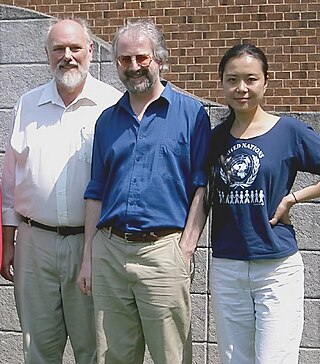Related Research Articles

Loricifera is a phylum of very small to microscopic marine cycloneuralian sediment-dwelling animals with 37 described species, in nine genera. Aside from these described species, there are approximately 100 more that have been collected and not yet described. Their sizes range from 100 μm to ca. 1 mm. They are characterised by a protective outer case called a lorica and their habitat is in the spaces between marine gravel to which they attach themselves. The phylum was discovered in 1983 by Reinhardt Kristensen, in Roscoff, France. They are among the most recently discovered groups of Metazoans. They attach themselves quite firmly to the substrate, and hence remained undiscovered for so long. The first specimen was collected in the 1970s, and later described in 1983. They are found at all depths, in different sediment types, and in all latitudes.
The Intergovernmental Oceanographic Commission of UNESCO (IOC/UNESCO) was established by resolution 2.31 adopted by the General Conference of UNESCO. It first met in Paris at Unesco Headquarters from 19 to 27 October 1961. Initially, 40 States became members of the Commission. The IOC assists governments to address their individual and collective ocean and coastal management needs, through the sharing of knowledge, information and technology as well as through the co-ordination of programs and building capacity in ocean and coastal research, observations and services.

The Census of Marine Life was a 10-year, US $650 million scientific initiative, involving a global network of researchers in more than 80 nations, engaged to assess and explain the diversity, distribution, and abundance of life in the oceans. The world's first comprehensive Census of Marine Life — past, present, and future — was released in 2010 in London. Initially supported by funding from the Alfred P. Sloan Foundation, the project was successful in generating many times that initial investment in additional support and substantially increased the baselines of knowledge in often underexplored ocean realms, as well as engaging over 2,700 different researchers for the first time in a global collaborative community united in a common goal, and has been described as "one of the largest scientific collaborations ever conducted".

Alcithoe aillaudorum is a species of sea snail, a marine gastropod mollusk in the family Volutidae, the volutes.

Minolia peramabilis, common name the lovely Pacific margarite, is a species of sea snail, a marine gastropod mollusk in the family Solariellidae.

Bathycrinicola micrapex is a species of sea snail, a marine gastropod mollusk in the family Eulimidae.
Emarginula agulhasensis is a species of sea snail, a marine gastropod mollusk in the family Fissurellidae, the keyhole limpets and slit limpets.
Emarginula thorektes is a species of sea snail, a marine gastropod mollusk in the family Fissurellidae, the keyhole limpets and slit limpets.
Fissurisepta onychoides is a species of sea snail, a marine gastropod mollusk in the family Fissurellidae, the keyhole limpets and slit limpets.
Puncturella capensis is a species of sea snail, a marine gastropod mollusk in the family Fissurellidae, the keyhole limpets and slit limpets.
Profundisepta voraginosa is a species of sea snail, a marine gastropod mollusk in the family Fissurellidae, the keyhole limpets and slit limpets.

Pliciloricus enigmaticus is a marine Loriciferan species of genus Pliciloricus described by Higgins & Kristensen 1986.

Pliciloricus is a genus of marine organisms Pliciloricidae family, the phylum Loricifera described by Higgins & Kristensen, 1986.

Pliciloricidae are a family of marine organisms in the phylum Loricifera. It contains 23 species in 4 genera.
Rugiloricus is a genus of marine organisms of the phylum Loricifera and the family Pliciloricidae, described by Higgins & Kristensen in 1986.
Pliciloricus dubius is a marine Loriciferan species of genus Pliciloricus described by Higgins & Kristensen 1986.
Robert Price Higgins is an American systematic invertebrate zoologist and ecologist, specializing in the unusual taxa of kinorhynchs and tardigrades.
Jeanne Renaud-Mornant, Born Jeanne Renaud, Jeanne Renaud-Debyser before her second marriage was a French biologist specialising in meiofauna.

The Ocean Biodiversity Information System (OBIS), formerly Ocean Biogeographic Information System, is a web-based access point to information about the distribution and abundance of living species in the ocean. It was developed as the information management component of the ten year Census of Marine Life (CoML) (2001-2010), but is not limited to CoML-derived data, and aims to provide an integrated view of all marine biodiversity data that may be made available to it on an open access basis by respective data custodians. According to its web site as at July 2018, OBIS "is a global open-access data and information clearing-house on marine biodiversity for science, conservation and sustainable development." 8 specific objectives are listed in the OBIS site, of which the leading item is to "Provide [the] world's largest scientific knowledge base on the diversity, distribution and abundance of all marine organisms in an integrated and standardized format".

Tony Rees is a software developer, data manager and biologist resident in Australia since 1986, and reviously a data manager with CSIRO Marine and Atmospheric Research. He is responsible for, among other systems:
References
- ↑ Higgins, Robert P.; Kristensen, Reinhardt M. 1986: New Loricifera from southeastern United States coastal waters Smithsonian Contributions to Zoology, 438 Smithsonian Institution Press: Washington D.C.. III, 70 pp. ISSN 0081-0282
- ↑ "Ocean Biogeographic Information System". www.iobis.org. Retrieved 7 September 2018.
- ↑ World Register of Marine Species (WoRMS) Rugiloricus cauliculus Higgins & Kristensen, 1986 AphiaID: 154511